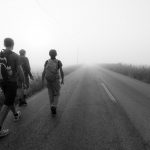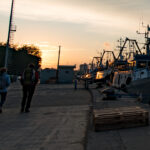Distance: Km 24
Estimated time: 7 h
Departure: Hermitage of Gamogna
Intermediate stages: Ponte della Valle, Trebbana, monumental oak, Passo della Collina, church of Cesata, convent of the Friars
Arrival: Concattedrale di Santo Stefano in Modigliana
N.B.: after Trebbana it could be difficult to find water
Description of the stage
Leaving the hermitage of Gamogna, follow the road the previous day, just before reaching the cemetery, take the CAI 521A path on the right that goes down to Ponte della Valle where there is a bar that closes the passage to the cars. Cross the bar and continue on Via di Valle Acerreta for 1 km until you meet a large space on the right (often used as a parking space). Arrived at the clearing, turn right, take the path CAI 549, cross the bridge and climb to Trebbana. Near Trebbana there are several testimonies of the presence, in those places, of Father Daniele Badiali, a dead priest murdered in Peru and whose cause of beatification is underway. The route continues, again on path 549, crossing the lawn in front of Trebbana; after a few hundred meters you reach a junction, path 549 continues on the right, but it is interesting to make a small detour by turning left, continuing for 50 meters and observing the monumental oak placed next to a ruin. Continuing along path 549, the CAI path 553 intersects that leads to the Collina pass. When you reach the pass, cross the road and take the path uphill that goes beyond the small point on the opposite side. After 500 meters intersects the dirt road Strada del Sole which, remaining close to the ridge, leads first to the Church of Cesata, then becomes Via dei Frati and leads to Modigliana. Just before reaching Modigliana, the Viae turns right, passing in front of the monastery of the Capuchin Friars, today the Incamminati campus, along the Via Crucis on the road and, through a path with a dirt staircase, leads to Piazza Battisti where the church of Santo Stefano Papa is located, the concactedrale of our diocese. If you want to stay overnight with the Franciscan Sisters of the Holy Family, go along via Puntaroli (exiting the church of Santo Stefano is the street on the left) for 200 meters and, at a chain that closes the route to the cars, turn left in via Francesco Maria Piazza. The convent is located at number 25.
Places of interest:
Church and Monastery of S. Michele in Trebbana
Trebbana is an ancient church dedicated to San Michele, with a large rectory attached. Its foundation dates back to 1063, when the church was donated to San Pier Damiani for the hermits of Gamugno. In the immediate vicinity there is the presence of an ancient oak tree (whose trunk measures 4.75 meters in circumference), also indicated in the cadastral maps and military maps. The extremely picturesque location of the place, on the border between Romagna and Tuscany, make it one of the most attractive and attractive locations in the area.
Church of Santa Reparata – Modigliana
The Church of Santa Reparata, from the 13th to the 14th centuries, has been largely rebuilt, especially since the last conflict. The current crypt was the apse of the original church. Inside there is a remarkable fresco with the Annunciation of the XV century, by an unknown artist (to be attributed to the Tuscan school of the end of the century).
The title of S. Reparata, which is to be compared to that of the church of Badia del Borgo di Marradi, reveals a direct influence of Florence, a city that had dedicated its first cathedral to this Saint. The extremely picturesque location of the place, on the border between Romagna and Tuscany, make it one of the most attractive and attractive locations in the area.
Modigliana
Modigliana is located in the Tramazzo valley and boasts very ancient origins and a rich history of important events that often crosses the local borders. Its medieval fortress was the cradle of the power of the Counts Guidi, lords of the Ghibelline side, who through more than 200 castles controlled a vast territory, extended between Romagna and Tuscany.
To see: Palazzo Pretorio in stone of the Tuscan type of the fourteenth century in the center of the old village, first palace of the Guidi Counts and from 1377 the seat of the podestà sent from Florence, houses the municipal art gallery with works by the painter Modiglianese Silvestro Lega and others ; Palazzo Borghi, of the late Tuscan Renaissance; the ‘Don Giovanni Verità’ Museum, birthplace of the Carbonaro priest, which has become the seat of the Risorgimento city museum with an archaeological section and a room dedicated to war and resistance.
The Tribuna (piazza Don Minzoni) was the main entrance to the castle consisting of two bell towers and a shrine with the statue of the Madonna; the bridge of S. Donato, called the ‘ponte della Signora’, with the back of a donkey, is made up of three arches, dating back to the XVIII century; the Duomo The Cathedral, formerly the parish church of S. Stefano (of which only the crypt remains, today the chapel of dead Jesus) and a pillar with arch next to the main altar, was consecrated by Pope Julius II in 1506. Enlarged in 1756, of bell tower in 1764, he saw the high altar completed in 1767 by the Milanese Giovanni Fossati. Among statues, paintings and decorations of considerable value, deserve mention, in particular, an oil on canvas depicting St. Stephen offering the city (by Paolo Cignani) and an oil on panel with the theme of the announcement of Francesco delle Querce and a “Pentecoste” by an anonymous author of the seventeenth century Tuscan school. The Sanctuary of the Madonna del Cantone, built for devotion to the image of the Madonna delle Grazie.












